
The Unicorn, from the Latin words unus meaning one and cornu meaning horn, is a legendary mythological creature known the world over from folktales, songs, poems, ancient bestiaries, and epic stories. Though the modern image of the Unicorn is that of a white steed with a single ivory horn protruding from its forehead, the more traditional image of the Unicorn has the beard of a goat, the tail of a lion and cloven hooves, depending on the region the Unicorn can take on other physical properties as well.
An early written account of the Unicorn appeared about 5,000 years ago in Chinese Mythology where the Unicorn can appear in many different physical forms but is most commonly described as having the body of a deer, the tail of an ox, the hooves of a horse and of course a single short horn growing out of the middle of its forehead. The hair on its back was said to contain the five sacred Chinese colors, which are red, yellow, blue, white and black, and is some times depicted with green scales like a dragon. 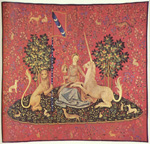 The Chinese Unicorn was known as the Kilin a combination of both the words Ki, the male Unicorn and Lin, the female Unicorn. It was said to have lived for roughly one thousand years and was always careful not to tread on even the tiniest living thing eating only plant life that had naturally died. It was believed that the appearance of the Unicorn was as sign of good time to come, and the fact that it has not been seen in many centuries is believed by some to suggest that we are living in bad times. These same people also believe that the Unicorn will reappear when the time is right and when goodness reigns.
The Chinese Unicorn was known as the Kilin a combination of both the words Ki, the male Unicorn and Lin, the female Unicorn. It was said to have lived for roughly one thousand years and was always careful not to tread on even the tiniest living thing eating only plant life that had naturally died. It was believed that the appearance of the Unicorn was as sign of good time to come, and the fact that it has not been seen in many centuries is believed by some to suggest that we are living in bad times. These same people also believe that the Unicorn will reappear when the time is right and when goodness reigns.
Chinese mythology also tells of how the Unicorn could foretell the birth of great men such as the philosopher Confucius whose pregnant mother was said to have met a Unicorn in the woods in 551 B.C. The Unicorn gave her a small piece of jade, a symbol of wisdom, and placed its head in her lap; she realized the importance of this event and took it as a good omen from the gods. Along the same lines the Unicorn was said to be able to foretell the death of great men and sure enough in Confucius’ old age he reportedly saw a Unicorn himself and knew it meant he would soon die.
In addition to China, other Asian countries also have traditions which involve Unicorn like creatures. In Japan it is known as the Kirin which has a shaggy mane and the body of a bull. Unlike the Chinese Unicorn, it was a beast to be feared, especially by criminals. The Kirin was said to be able to detect guilt, Japanese judges even went as far as to call upon the beast when they themselves could not determine the guilty party. Upon delegating guilt the Kirin would cast its gaze upon the criminal and pierce him through the heart with its horn. 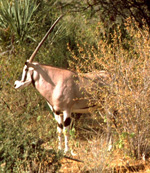 By the 4th century B.C. the Unicorn had become a very popular animal in the Western world and was made mention of in the writings of Greek historian and physician Ctesias, who returned from his travels to Persia with fantastic stories of a creature he called the wild ass of India. Though he himself did not witness one of these creatures they were described to him as being equal in size to a horse, with a white body, a red head, bluish eyes and a straight horn which grew from its forehead. He further described the lower part of the horn as being white, the middle black and the tip red.
By the 4th century B.C. the Unicorn had become a very popular animal in the Western world and was made mention of in the writings of Greek historian and physician Ctesias, who returned from his travels to Persia with fantastic stories of a creature he called the wild ass of India. Though he himself did not witness one of these creatures they were described to him as being equal in size to a horse, with a white body, a red head, bluish eyes and a straight horn which grew from its forehead. He further described the lower part of the horn as being white, the middle black and the tip red.
As a physician stories that this creature’s horn protected against deadly poison especially interested Ctesias who would later learn that drinking cups made from the horn of a Unicorn were believed to possess the power of neutralizing poisons if one were to drink from them.
Shortly after Ctesias’ stories of the Unicorn became known the famous Greek philosopher Aristotle deduced that the Unicorn was more than likely a real animal; however he did not believe that the creature’s horn contained any magical powers. The respected historian Pliny the Elder included the Unicorn in his master work, Historia Naturalis, and came to the conclusion that the Unicorn did, in fact, existed in India.
Unlike the typical Unicorn in Western mythology Pliny’s version of the creature was a ferocious beast with the body of the horse, the head of a deer, the feet of an elephant, the tail of a wild boar and a single black horn protruding from its forehead. Both Pliny the Elder and Aristotle deducted that there was no more reason to doubt the existence of the Unicorn than that of an elephant or giraffe, pointing out that just because they had never personally seen one did not mean it did not exist. 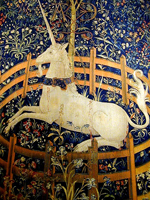 Belief in the Unicorn continued during medieval times and stemmed from both Biblical and ancient accounts of the creature. According to the book of Genesis, God gave Adam the task of naming everything he saw and in some translations of the Bible, the Unicorn was the first creature named, thereby elevating it above all other beasts in the universe. When Adam and Eve were forced to leave paradise the Unicorn went with them and came to represent purity and chastity, thus the belief in the Unicorn’s purity is thought to have stemmed from its Biblical beginnings.
Belief in the Unicorn continued during medieval times and stemmed from both Biblical and ancient accounts of the creature. According to the book of Genesis, God gave Adam the task of naming everything he saw and in some translations of the Bible, the Unicorn was the first creature named, thereby elevating it above all other beasts in the universe. When Adam and Eve were forced to leave paradise the Unicorn went with them and came to represent purity and chastity, thus the belief in the Unicorn’s purity is thought to have stemmed from its Biblical beginnings.
The Bible also offers its explanation as to why the Unicorn has not been seen in such a long period of time. During the great flood, that engulfed the world for 40 days and 40 nights, Noah took two of every animal and placed them aboard his Arc so that they may survive, however the Unicorns were not among them. A Jewish folk tale mentions that the Unicorn was original aboard the Arc, but demanded so much space and attention that Noah banished them. When the world began to flood these Unicorns most assuredly drowned, however some believe that they evolved into the Arctic narwhale.
By 200 A.D., noted Christian apologist Tertullian had dubbed the Unicorn a small fierce kidlike animal and a symbol of Christ himself, its horn later to become symbolic of the unity of Christ and God. Some have argued that the due to the strong belief in the Unicorn’s existence in the Bible that the creature must have, at one point, existed. However there are those who believe that during the translation of the bible the term Unicorn was mistranslated and used in place of several other horned animals, causing it to appear in the Bible more than originally intended.
As time passed and explorers began to sail the earth they would often return with tales of fantastic monsters and animals from the far off places they had been. One such report, by famous explorer Marco Polo, described a creature that he called a Unicorn as follows: 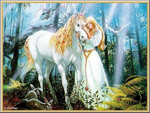 Scarcely smaller than elephants. They have the hair of a buffalo and feet like an elephant's. They have a single large black horn in the middle of the forehead... They have a head like a wild boar's… They spend their time by preference wallowing in mud and slime. They are very ugly brutes to look at. They are not at all such as we describe them when we relate that they let themselves be captured by virgins, but clean contrary to our notions.
Scarcely smaller than elephants. They have the hair of a buffalo and feet like an elephant's. They have a single large black horn in the middle of the forehead... They have a head like a wild boar's… They spend their time by preference wallowing in mud and slime. They are very ugly brutes to look at. They are not at all such as we describe them when we relate that they let themselves be captured by virgins, but clean contrary to our notions.
Its is fairly clear by his description of the Unicorn that Marco Polo was describing a rhinoceros leading many modern researchers to speculate that the entire Unicorn legend may have stemmed from sightings of a one horned creature like the rhinoceros by an individual who had never before seen such an animal.
Many Unicorn legends suggest that there is only one way in which a hunter would ever be able to catch a Unicorn. This traditional method of hunting Unicorns involved the beast’s entrapment by a virgin. In one of Leonardo de Vinci’s notebooks he wrote that the Unicorn, through its intemperance and not knowing how to control itself, for the love it bears to fair maidens forgets its ferocity and wildness, and laying aside all fear it will go up to a seated damsel and go to sleep in her lap, and thus the hunters take it.  The famous late Gothic series of seven tapestry hangings, The Hunt of the Unicorn, which now hang in the Cloisters division of the Metropolitan Museum of Art in New York, are considered by some to be the high point of European tapestry manufacturing. In this series, richly dressed noblemen, accompanied by huntsmen and hounds, pursue a Unicorn against a setting of buildings and gardens.
The famous late Gothic series of seven tapestry hangings, The Hunt of the Unicorn, which now hang in the Cloisters division of the Metropolitan Museum of Art in New York, are considered by some to be the high point of European tapestry manufacturing. In this series, richly dressed noblemen, accompanied by huntsmen and hounds, pursue a Unicorn against a setting of buildings and gardens.
They bring the animal to bay with the help of a maiden who traps it with her charms, appearing to kill it, and bring it back to the castle. In the last and most famous of these seven panels, entitled The Unicorn in Captivity, the Unicorn is shown alive again and happy, chained to a pomegranate tree surrounded by a circular fence in a field of flowers. The series was woven for an unknown patron in about 1500 in the Low Countries, probably Brussels or Liege.
With so many accounts and world wide reports of the Unicorn, mainly from long ago, modern researchers have suggested a plethora of theories as to the true identity of the original Unicorn. As mentioned above some researchers have suggested that original Unicorn reports may have stemmed from encounters between Europeans and the rhinoceros. Humans who lived during the time of the last major Ice Age would have been quite familiar with the wooly rhinoceros; their legends of these beasts may have been pasted down through the generation eventually evolving into to what we know today as the Unicorn.
Furthermore, Europeans and West Asians have been traveling to Sub Saharan Africa for as long as we have documented records. Also Chinese from as far back as the Han Dynasty, around 220 B.C., were traveling to East Africa leading some to speculate that these early travels may have all encountered the rhinoceros and, not known what it was, mistaken it for the Unicorn. In support of this theory, 13th century explorer Marco Polo claimed to have seen a Unicorn in Java, but his description, which can be found above, makes it clear to modern readers that he actually saw a Javanese rhinoceros.
Another theory suggests that the Unicorn is based on a now extinct animal, sometimes called the Great Unicorn, known to science as the Elasmotherium, a huge Eurasian rhinoceros. Elasmotherium is thought to have looked a little something like a horse, but it had a large single horn protruding from its forehead. It is thought to have gone extinct at about the same time as the rest of the glacial age mega fauna, like the wooly rhinoceros and wooly mammoth, about 1.6 million years ago. However, according science writer Willy Ley and the Nordisk Familybook, published between 1876 and 1899, the animal may have survived long enough to be remembered in the legends of the Evenk people of Russia as a huge black bull with a single horn in its forehead. 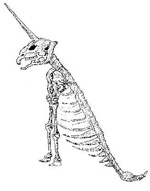 There is also testimony by the medieval traveler Ibn Fadlan, who is usually considered a reliable source, which suggests that Elasmotherium may have survived into historical times, his testimony reads as follows:
There is also testimony by the medieval traveler Ibn Fadlan, who is usually considered a reliable source, which suggests that Elasmotherium may have survived into historical times, his testimony reads as follows:
There is nearby a wide steppe, and there dwells, it is told, an animal smaller than a camel, but taller than a bull. Its head is the head of a ram, and its tail is a bull’s tail. Its body is that of a mule and its hooves are like those of a bull. In the middle of its head it has a horn, thick and round, and as the horn goes higher, it narrows until it is like a spearhead. Some of these horns grow to three or five ells, depending on the size of the animal. It thrives on the leaves of penof trees, which are excellent greenery. Whenever it sees a rider, it approaches and if the rider has a fast horse, the horse tries to escape by running fast, and if the beast overtakes them, it picks the rider out of the saddle with its horn, and tosses him in the air, and meets him with the point of the horn, and continues doing so until the rider dies. But it will not harm or hurt the horse in any way or manner.
The locals seek it in the steppe and in the forest until they can kill it. It is done so: they climb the tall trees between which the animal passes. It requires several bowmen with poisoned arrows; and when the beast is in between them, they shoot and wound it unto its death. And indeed I have seen three big bowls shaped like Yemen seashells, that the king has, and he told me that they are made out of that animal’s horn.
Even if the Elasmotherium is not the creature described by Ibn Fadlan, it only leads us back to the original theory an ordinary rhinoceros may have some relation to the Unicorn.
Other animals suggested as possible sources of the original Unicorn legend include the following:
The oryx, an antelope like animal with two long, thin horns projecting from its forehead. Some researchers have suggested that, seen from the side and from a distance, these two horns appear as one, though the horn projects backwards not forward as in the classic Unicorn, the oryx its self has a similar appears as a horse for a distance. These same researchers believe that travelers in Arabia could have derived tales of the Unicorn from these animals. Published in 1486, The Peregrinatio in terram sanctam was the first printed illustrated travel book. It describing a pilgrimage to Jerusalem and thence to Egypt by way of Mount Sinai. It featured many large woodcuts by Erhard Reuwich, who went on the trip, mostly detailed and accurate views of cities. The book also contained pictures of animals seen on the journey, including a crocodile, camel, and unicorn, presumably an oryx, which they could easily have seen on their route.
The eland, a very large antelope like creature, thought to be somewhat mystical or spiritual perhaps at least partly because it would defend its self and others against lions and was able to kill these fearsome predators at a time when people only had slow acting poisoned arrows to defend themselves with. Eland are very frequently depicted in the rock art of the region, which implies that they were viewed as having a strong connection to the other world, and in several languages the word for eland and for dance is the same; significant because shamans used dance as their means of drawing power from the other world. Eland fat was used when mixing the pigments for these pictographs, and in the preparation of many medicines. This special regard for the eland may well have been picked up by early travelers. It is even rumored in the area of Cape Town one horned eland were known to occur naturally, perhaps as the result of a recessive gene.
The narwhal, this ocean dwelling mammal has also been suggested as the source of the original Unicorn legends, not so much the live swimming version but skeletal remains which would have possessed the long narrow horn. It is not hard to imagine that a person coming across the skeletal remains of a narwhal may have pieced it back together in a way in which it would have looked nothing like the narwhal and could have taken on the appearance of a land animal. Unicorn horns often found in cabinets of curiosities in Medieval and Renaissance Europe were very often nothing more than the distinct straight spiral tusk of the narwhal. It is believed that the usual depiction of the Unicorn horn in art derives from the narwhal tusk.
The domestic goat, a rare deformity of the generative tissues can cause the horns of the ordinary goat to become joined together, producing an animal which can look extraordinary; such an animal could be another possible inspiration for the original unicorn legends, especially those from ancient China which depict the Unicorn as being rather goat like in physical appearance.
As you can see there have been more than enough theories as to the possible original identity of the Unicorn, though none of which really explain the magical characteristics of the beast, which are thought by most to be a by product of the human imagination. We may never really know what was behind the creation of the Unicorn legend and we must not forget about those who believe that the creature behind the Unicorn legend might just be an actual Unicorn, a magical creature who awaits the onset of good to return to its former place in the world.
The Evidence
There is currently no physical evidence to support the existence of the creature described in most Unicorn legends.
The Sightings
Adam first saw the Unicorn in the Garden of Eden; it was the first of the Earths creatures to be named by Adam this securing a special place over all the animals in the universe.
It is said that almost 5,000 years ago a Unicorn appeared to give Chinese Emperor Fu Hsi the secrets of written language.
In 2697 B.C. it is said that a Unicorn made an appearance in the garden of China’s Yellow Emperor, Huang Di.
In about 2000 B.C. Chinese Emperor Yao is said to have had a run in with a Unicorn.
In 551 B.C., Confucius' pregnant mother met a Unicorn in the woods. It gave her a small piece of jade and placed its head in her lap. She realized the importance of the event and knew it was a good omen from the gods.
It is said that legendary philosopher Confucius once sighted a Unicorn.
In the 3rd century B.C., the Macedonian general Alexander the Great boasted that in one of his conquests, he rode a Unicorn into battle.
In the 1st century B.C, Roman Emperor Julius Caesar reported seeing a Unicorn in the deep forests of southwestern Germany.
In the mid 1100's Prester John ruled over a vast Asian empire and was reputed to have a number of tame Unicorns.
In the late 1200sItalian trader Marco Polo became famous for his accounts of travel in China and Southeast Asia. He even reported seeing a large Unicorn, almost as big as an elephant. His detailed description was almost certainly a rhinoceros, but the retelling of his tales and the illustrations that accompanied them usually made the Unicorn fit in with the traditional Western horse like creature.
The Stats – (Where applicable)
• Classification: Hybrid
• Size: Reports vary from that of a goat to slightly smaller than an elephant
• Weight: Unknown
• Diet: Herbivore
• Location: World Wide
• Movement: Four legged walking
• Environment: Forests, grasslands and plains
|